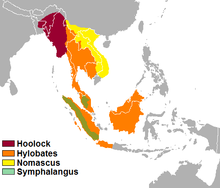Hylobatidae
| Gibbons Temporal range: 8–0 Ma Late Miocene–Recent |
|
|---|---|
 |
|
| Lar gibbons (Hylobates lar) | |
| Scientific classification | |
| Kingdom: | Animalia |
| Phylum: | Chordata |
| Class: | Mammalia |
| Order: | Primates |
| Suborder: | Haplorhini |
| Superfamily: | Hominoidea |
| Family: |
Hylobatidae Gray, 1870 |
| Type genus | |
|
Hylobates |
|
| Genera | |
 |
|
| Distribution in Southeast Asia | |
Hylobates
Hoolock
Nomascus
Symphalangus
Gibbons are apes in the family Hylobatidae. The family historically contained one genus, but now is split into four genera and 18 species. Gibbons occur in tropical and subtropical rainforests from eastern Bangladesh and northeast India to southern China and Indonesia (including the islands of Sumatra, Borneo, and Java).
Also called the smaller apes or lesser apes, gibbons differ from great apes (chimpanzees, bonobos, gorillas, orangutans, and humans) in being smaller, exhibiting low sexual dimorphism, and not making nests. In certain anatomical details, they superficially more closely resemble monkeys than great apes do, but like all apes, gibbons are tailless. Gibbons also display pair-bonding, maintaining the same mate for life, unlike most of the great apes (this has been disputed by Palombit and others, who have found that gibbons might be socially monogamous, with occasional "divorce", but not sexually monogamous). Gibbons are masters of their primary mode of locomotion, brachiation, swinging from branch to branch for distances up to 15 m (50 ft), at speeds as high as 55 km/h (34 mph). They can also make leaps up to 8 m (26 ft), and walk bipedally with their arms raised for balance. They are the fastest and most agile of all tree-dwelling, nonflying mammals.
...
Wikipedia
